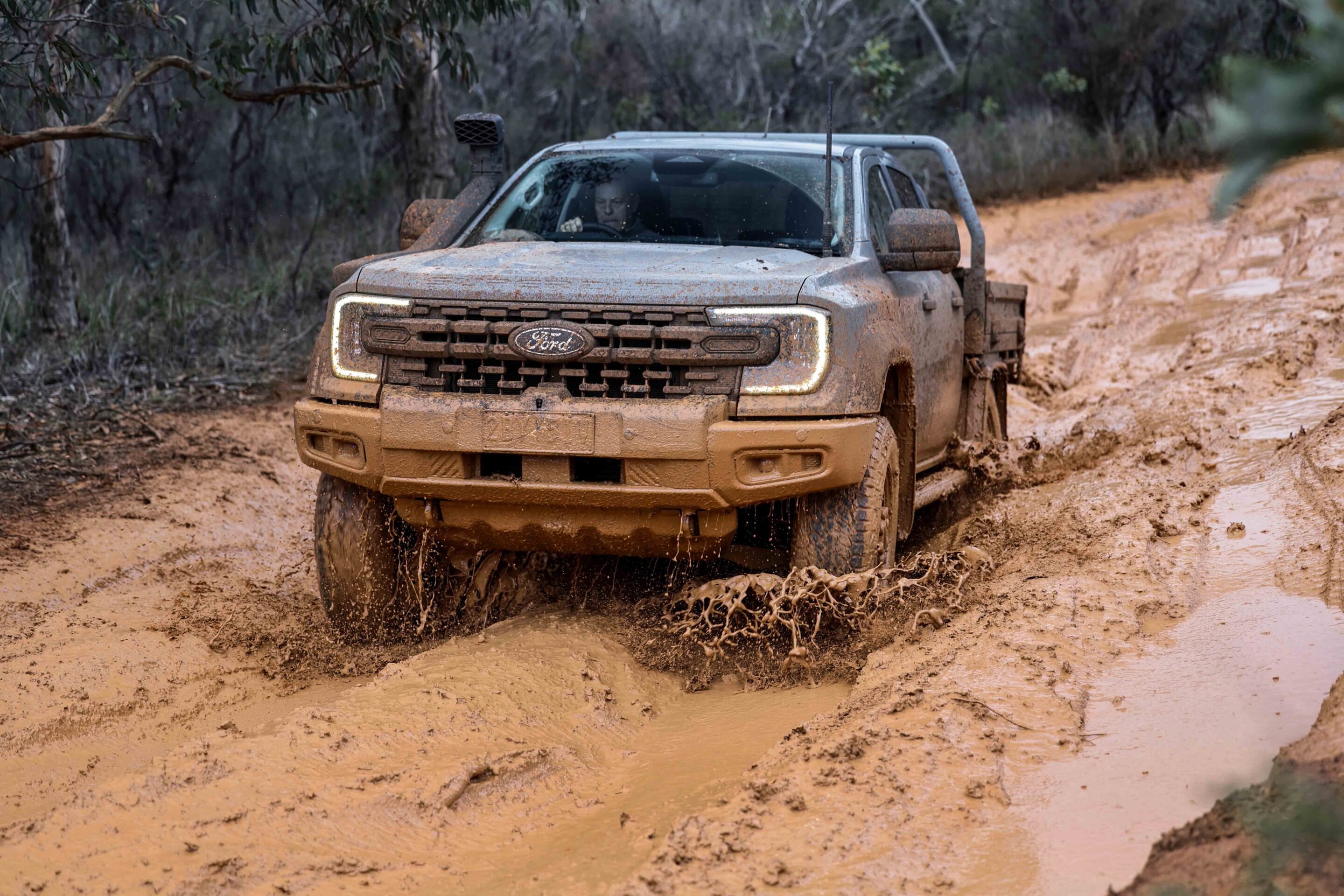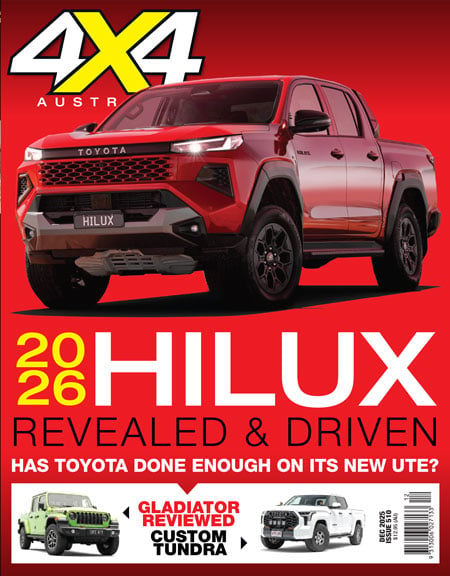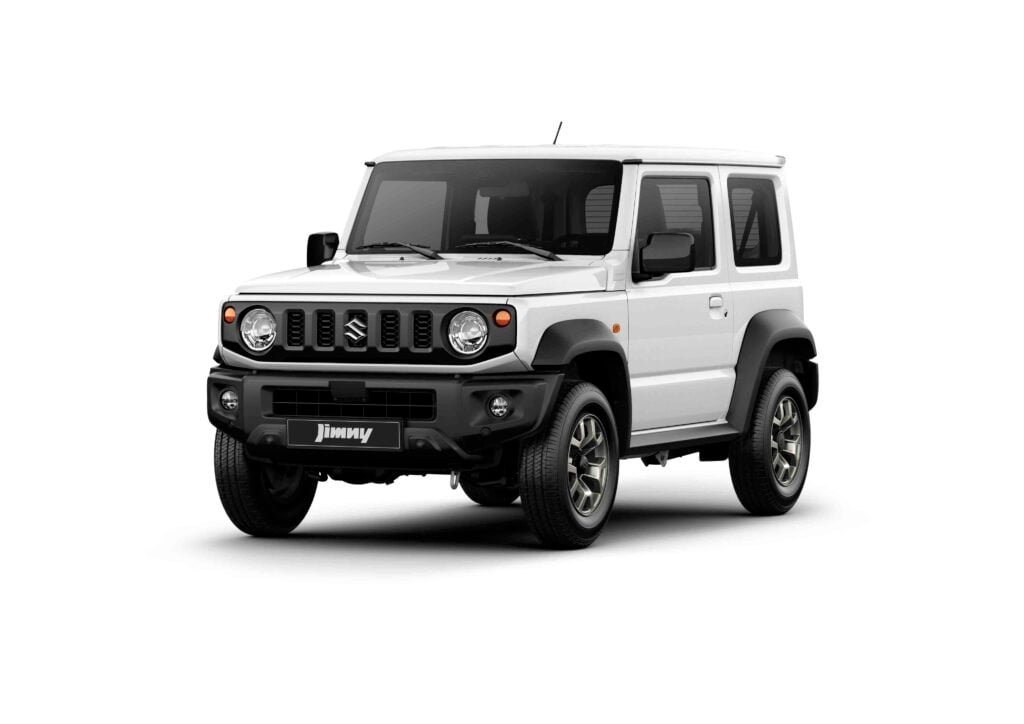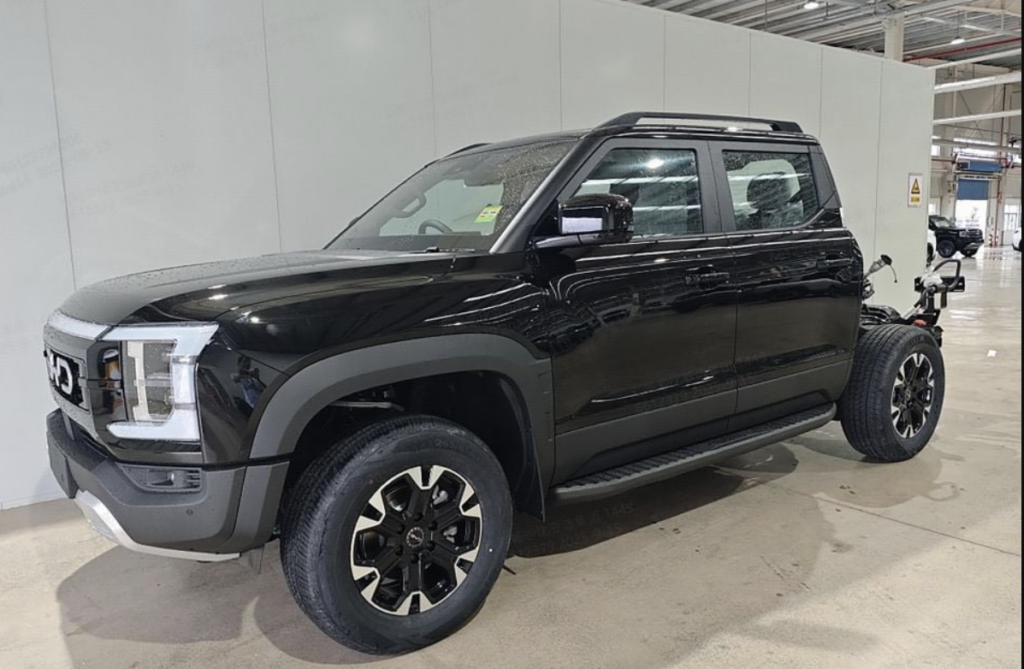When the team at Ford Australia first told us about its upcoming Ranger Super Duty, my initial reaction was that it sounded like an answer to a question nobody had asked. As it turns out, I couldn’t have been more wrong – because Ford had been asking the question all along.
Around seven years ago – before the current-generation Ranger had even been revealed – a group of senior Ford Australia managers and engineers hit the road to speak directly with private and business owners of four-wheel-drive utes. They wanted to understand how people were actually using their vehicles and, more importantly, what they wanted from them. What would be on the wish list for the ideal working 4×4 ute?
This survey wasn’t limited to owners of midsize utes like the Ranger. It also included managers of heavy-duty ute fleets – such as LandCruiser 79 Series operators – as well as businesses running full-size US-made pick-up trucks. What they discovered aligns closely with what we hear at 4X4 Australia: the number-one issue is weight. Whether it’s a ute loaded to the hilt on a mine site or cattle station, or hauling a big caravan along the highway, most vehicles simply aren’t up to the task in standard form.
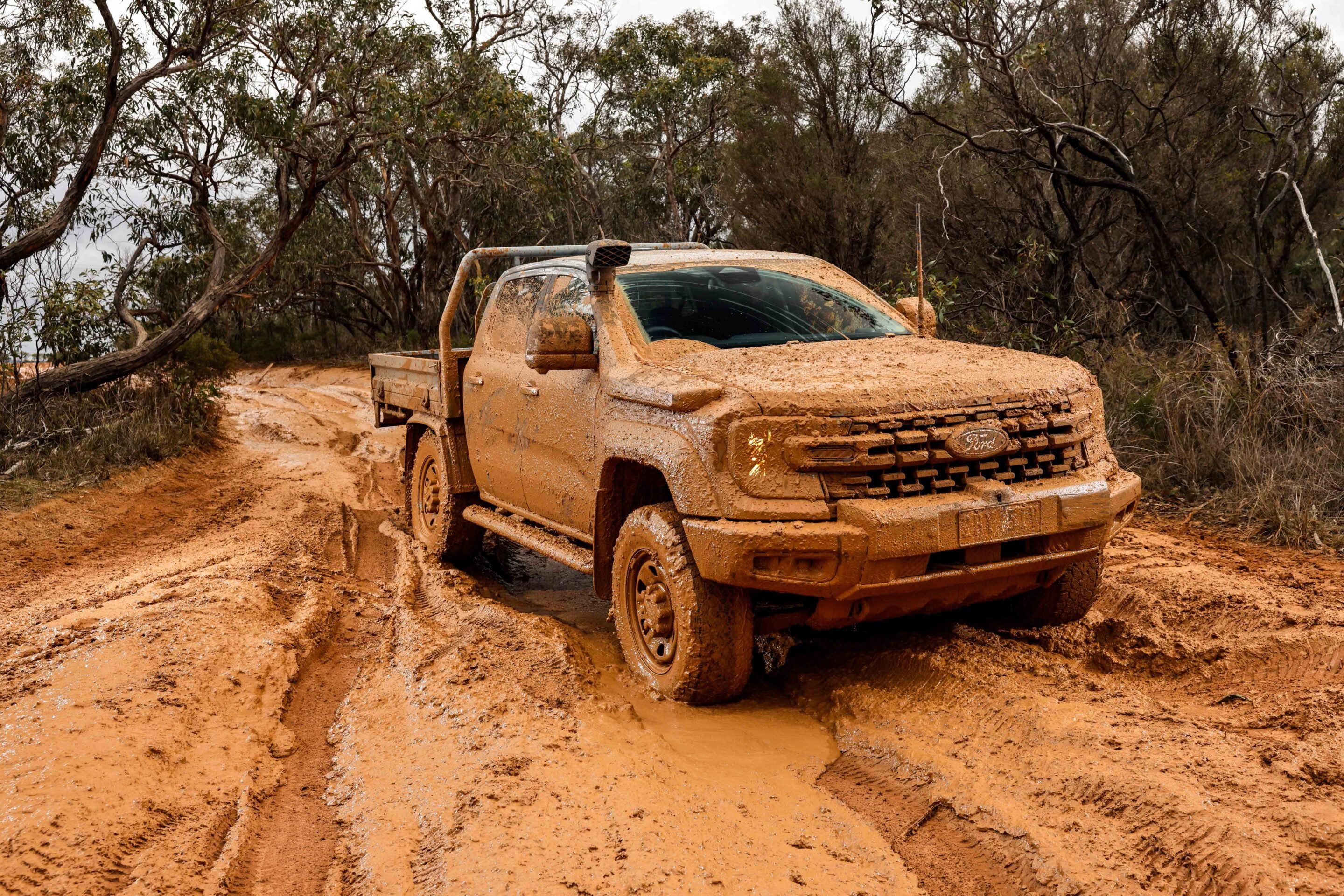
The only real alternatives have been the heavy-duty US pick-ups – but many buyers don’t want something that large. And while those trucks can tow massive trailers, a lot of them have relatively low payloads and aren’t built for the punishing conditions of Australia’s outback tracks.
Sure, you can get an aftermarket GVM upgrade, but many buyers don’t want the added cost, complexity or uncertainty that comes with going down that path – especially the big fleet managers overseeing dozens, sometimes hundreds, of vehicles. They were tired of buying a brand-new ute, only to then send it straight to a third party for a GVM upgrade and modifications, and later having to juggle multiple providers for servicing, repairs and maintenance depending on which component needed attention.
What they really wanted was a ute with higher load and towing capacities from the factory, and the ability to kit it out using manufacturer-approved suppliers. In short, a one-stop shop for a do-it-all vehicle, whether it’s destined for work or play.
Super Duty development
The Ford team travelled across large parts of Australia talking to as many ute owners as possible, and returned to Melbourne with a solution.
The first step was to build a business plan for what they wanted, based on the feedback gathered on the trip, then get approval from the brass in Dearborn to put the plan into action. What the team wanted was a Ranger Super Duty – a nameplate only ever applied to the heavy-duty versions of the iconic Ford F-trucks. We’re talking F-250 and above here, and the Super Duty name had never been applied to a mid-size truck.
Super Duty is not a title that Dearborn hands out willy-nilly like so many sticker-pack specials we’re used to in the mid-size 4×4 ute segment. No, Super Duty has to be earned, and there are standards that must be met before a Ford truck can wear that badge of honour. In fact, you can’t even buy a Super Duty badge – the mark is stamped into the vehicle’s sheetmetal, across the hood (I mean bonnet) and across the tailgate. You can’t just walk into a parts store and buy a Ford Super Duty badge to stick on any old ute.
The Australian team was convincing and, after outlining their plan, soon got the tick of approval to proceed with the project. That was just the first hurdle – the next was how to implement it.
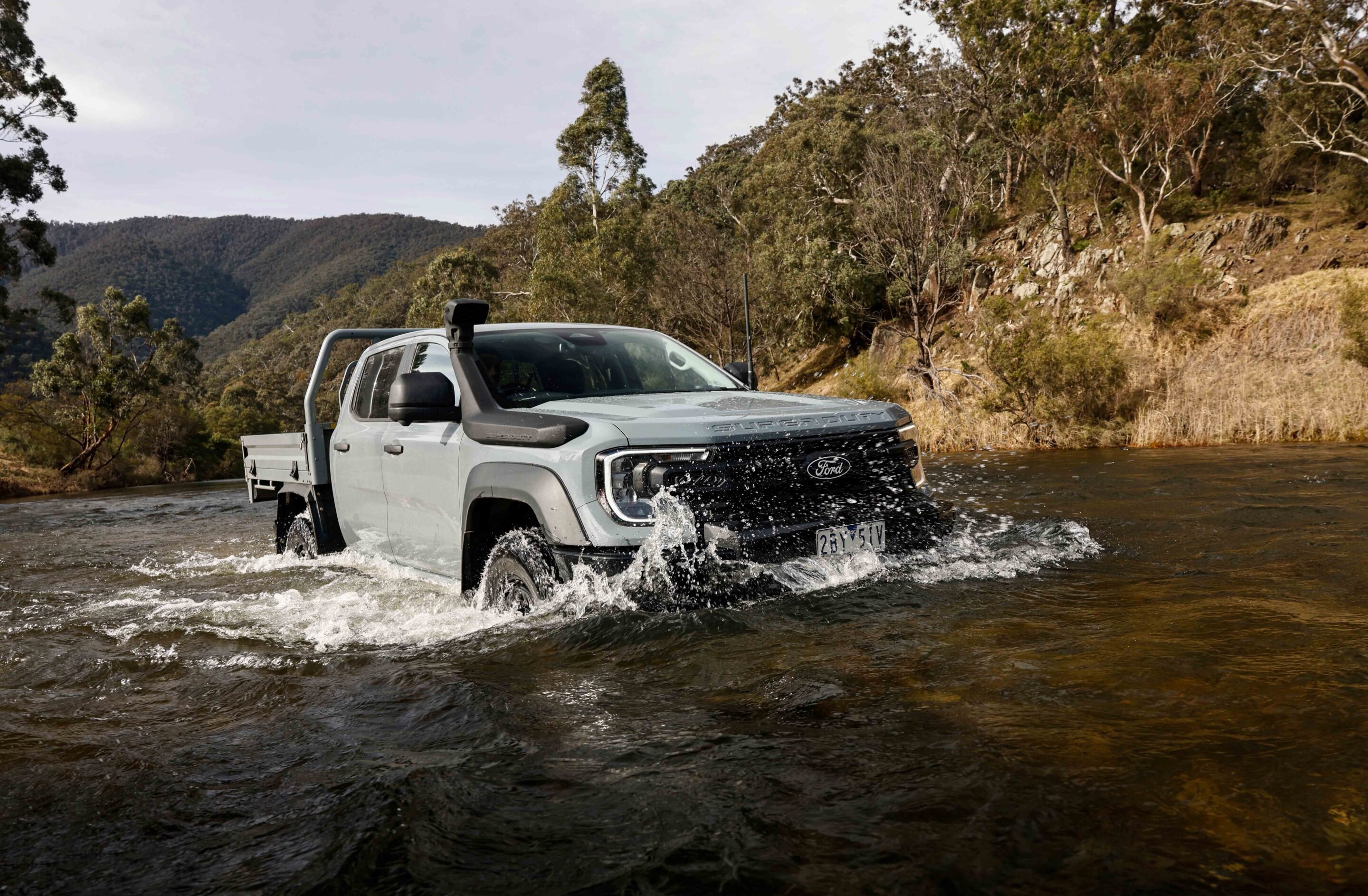
Chassis and suspension upgrades
Ford Australia’s plan was to create a Ranger – still the P703 model and still on the T6 platform – but one capable of a 4500kg GVM, towing a trailer of the same weight, and achieving a legal 8000kg GCM.
This would give users a vehicle no larger than a standard Ranger, with all the usual features and conveniences, yet offering the towing capacity of the full-size trucks and a payload to out-haul them. It was a big ask, but globally Ford has a deep pool of talented engineers and proven products to draw from.
While the stamping says Super Duty, the core of the product is a heavy-duty 4×4 truck. That meant engineering a chassis, suspension and driveline that could handle the target capacities in the harshest, most remote conditions. The T6 platform is retained, but the chassis is now thicker and heavier-duty to support the increased loads. Ford tells us that only six per cent of the chassis is carried over from a regular Ranger – and even then, it’s limited to some mounting brackets.
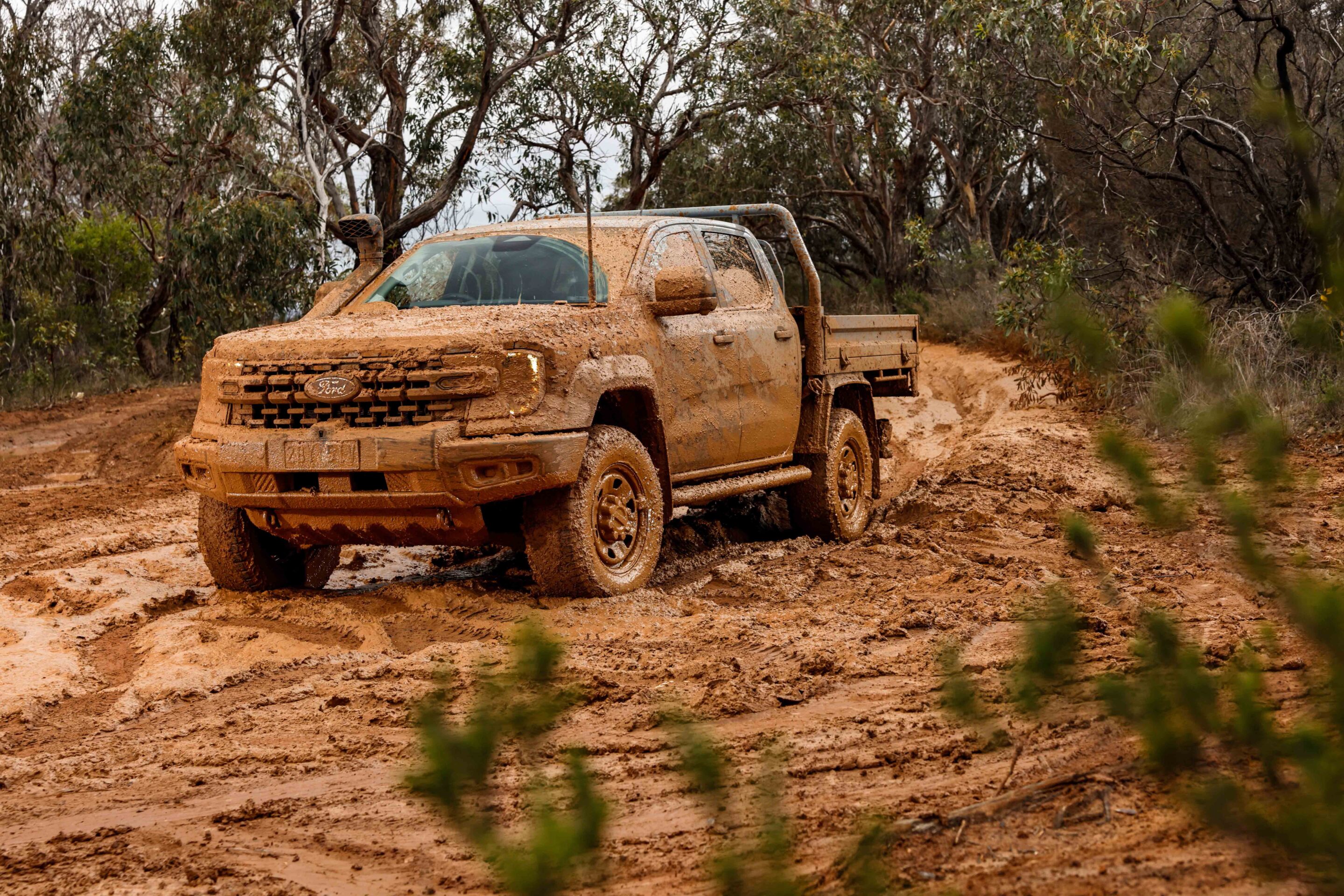
Midway down the chassis is a 130-litre fuel tank with its own crossmember for support and a heavy-duty bash plate underneath for protection. In fact, all underbody components are well protected by metal plates, while the increased ride height keeps them further off the ground.
The Super Duty chassis is so different that popular accessories such as bullbars and side steps from a standard Ranger will not fit; they must be specifically designed and engineered for the Super Duty. For axles, the team delved into the Ford parts bin, but even these production components have been re-engineered to meet the demands of the Super Duty.
The front differential is derived from a Ford Bronco Raptor but has been beefed up with heavier-duty half-shafts, CV joints, strengthened gears and other internal components. The Super Duty Ranger also gains a locking front differential for off-road performance. The front hubs were adapted from the F-250 and, significantly, use an eight-stud bolt pattern.
The Ford team says the eight-stud wheels were required because it was the only way to achieve the clamping force needed to secure the wheel at the loads the vehicle is designed for. The front suspension features Super Duty–specific upper and lower aluminium cast control arms and uprights, all rated to handle SD loads.
As for the rear axle, it shares the same stud pattern but is derived from a Ford Transit Jumbo rear end. Again, it has been beefed up with strengthened gears, larger axles and the heavy-duty components needed to cope with an 8000kg GCM, and it has been converted to a full-floating design. It’s a huge diff and worth checking out by sticking your head under the back of the Super Duty — the same goes for the strengthened front suspension hardware.
The transfer case in the Ranger SD is another upgraded component, and significantly it offers only 4×4 Auto and locked high- and low-range modes, with no 2WD setting. Ford says that with the loads the SD is engineered to carry, the AWD-style 4×4 Auto mode is the best and safest option for users.
The Super Duty has a wider wheel track than a regular Ranger, matching that of the Ranger Raptor. The wheelbase is unchanged, but the rear leaf-spring mounts have been shifted to accommodate longer leaf packs, providing increased wheel travel. All suspension and chassis mounts have been reinforced to cope with the expected loads of the Super Duty.
Steel 18-inch wheels are fitted to the standard Super Duty, with Super Duty–branded alloy wheels to come when the XLT model launches in mid-2026. The move to 18-inch wheels was necessary to accommodate a larger disc-brake package to meet SD requirements.
The tyres fitted to the Ranger SD are LT275/70R18 (33-inch) General Grabber all-terrains, again rated to handle heavier loads. The front wheel arches, and the rear arches on the XLT with a tub, have been designed to provide additional clearance for the taller tyres and longer wheel travel.
Engine, torque and towing
The capacities of the Ranger Super Duty put it in the N2 vehicle class, which required changes to the 3.0-litre V6 diesel engine we’re used to in the Ranger. The recalibration reduces peak power from 165kW to 154kW but retains the 600Nm peak torque figure.
The cooling system has been upgraded with the 8000kg GCM in mind, including a 1000W electric fan with 25 per cent more capacity than the regular Ranger V6 unit. The Super Duty radiator grille has also been designed to allow greater airflow through to the fan.
The Super Duty comes with a model-specific intake snorkel, developed and manufactured by Safari to suit the new sheetmetal and feed air to the V6. Combined with the increased ride height, it gives the Super Duty a higher wading depth of 850mm. Helping further are raised breathers for all driveline components, tucked high on the chassis to vent heat and prevent water ingress. The N2 category also requires the engine to run AdBlue, which has now been incorporated into the Super Duty.
Another insight from the Ford team’s customer road trip was that many users didn’t want the DPF to perform automatic regenerations, as the increased heat can easily start fires in dry grass or paddocks. As a result, DPF regen can now be postponed and controlled manually via a button, with a dash warning advising when a regen is required.
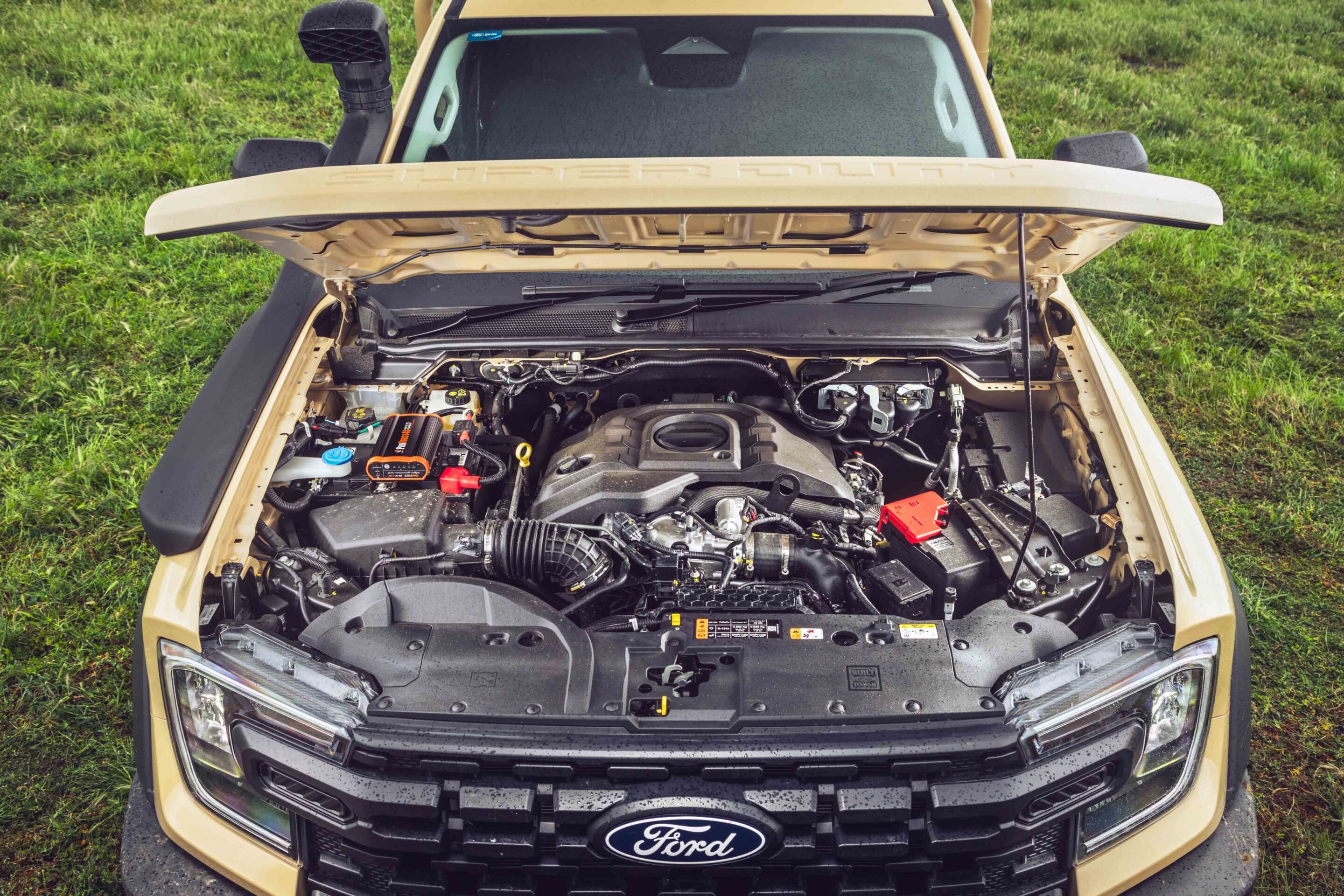
Body, clearance and off-road
We mentioned the new sheetmetal where the snorkel bolts on, and this is all part of an SD-only front-end redesign.
The guards are taller and have higher wheel openings for the increased wheel travel and tyre height. The bonnet and grille are both SD-specific items, and a metal bumper mounts directly to the front of the chassis. The bumper has mounts for accessories such as lights, aerials or a sand flag, but it’s not designed to carry a powered winch. For a winch you’ll need a bullbar or other aftermarket front bumper. Ford’s partnership with ARB 4×4 Accessories has given the brand a head start, and ARB has already developed bars and other products for the Super Duty. You can bet other manufacturers won’t be far behind with their own SD accessories.
The cab section will come in single, extra and double-cab configurations and is carried over from the regular Ranger range. The wider wheel track of the Super Duty also allows for a wider rear tray, which you can clearly see in the mirrors. Those mirrors are larger than regular Ranger items, though accessory towing mirrors are still recommended.
SD debuts a new DAT rear bar that mounts under the integrated 4500kg-rated towbar and houses all of the Driver Assistance Tech hardware such as parking sensors, cameras and tow-control sensors. These components previously had to be relocated or deleted when fitting a tray or service body, but with the DAT bar they’re fully retained with full functionality.
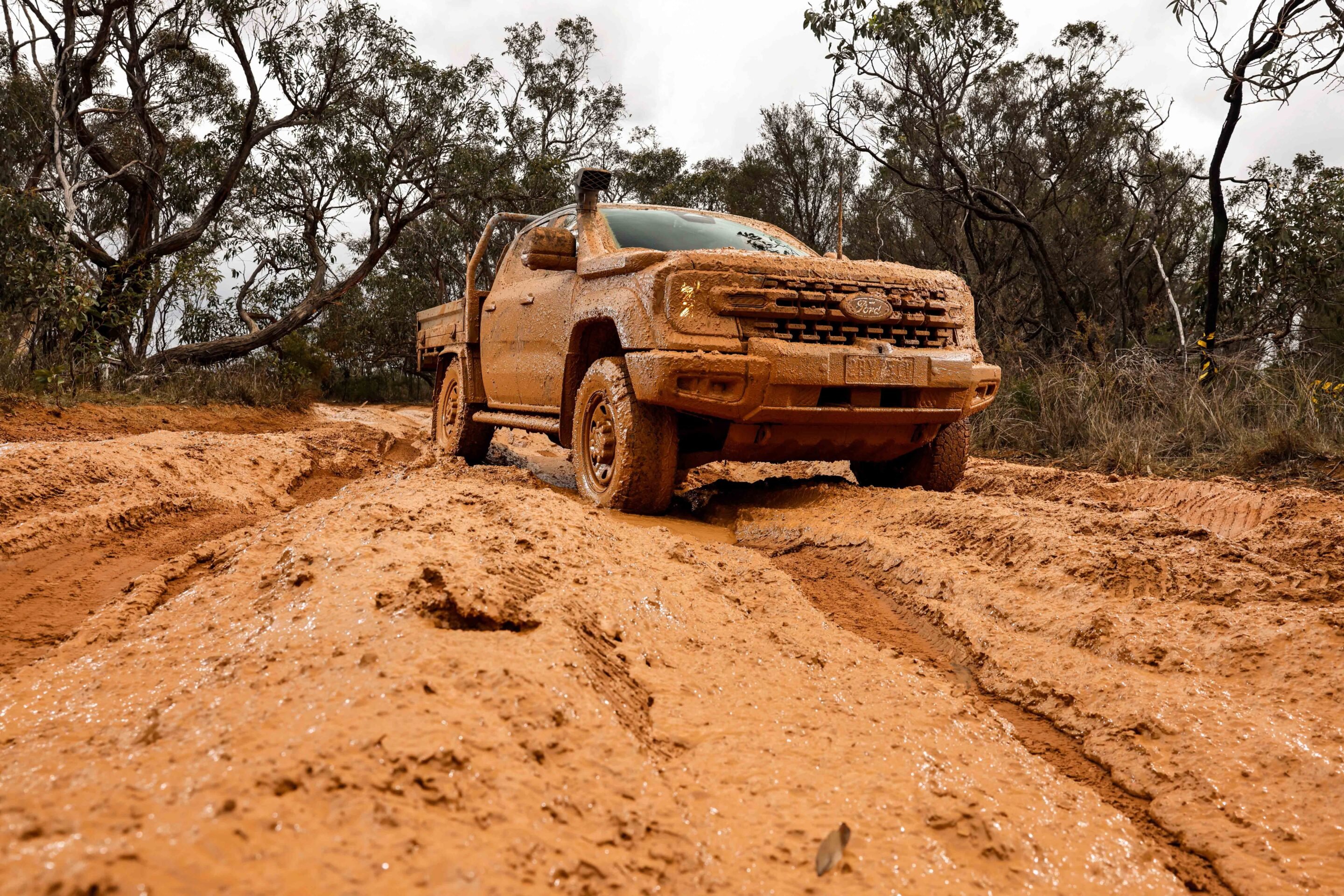
Interior, tech and comfort
Cab-chassis Super Duties are available in a single specification, featuring cloth seats, the 12-inch multimedia screen, an 8-inch driver display, vinyl floor coverings, wireless phone charger, auxiliary switch panel, drive modes, and all the usual Ranger ADAS and safety tech. Smart Hitch towing aids and an integrated trailer brake controller are also included for those who tow.
Keep an eye out for our first drive impressions landing TOMORROW MORNING!
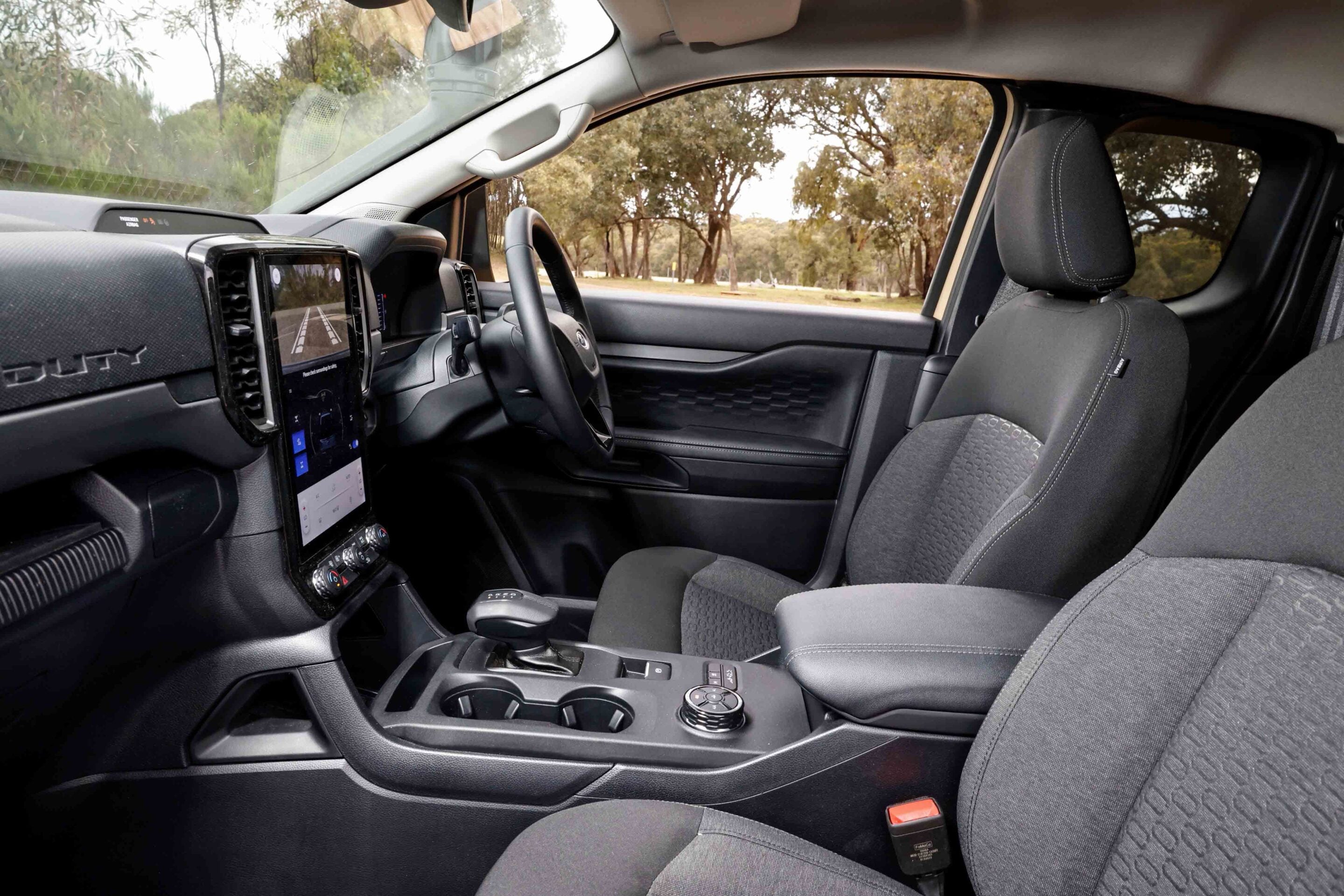
2026 range and prices
| Model | Price |
|---|---|
| Single-cab chassis | $82,990 |
| Double-cab chassis | $86,490 |
| Double-cab chassis (HD pack) | $89,990 |
| Double-cab pick-up | Mid-2026 release |
| XLT Series | From mid-2026 |
We recommend
-
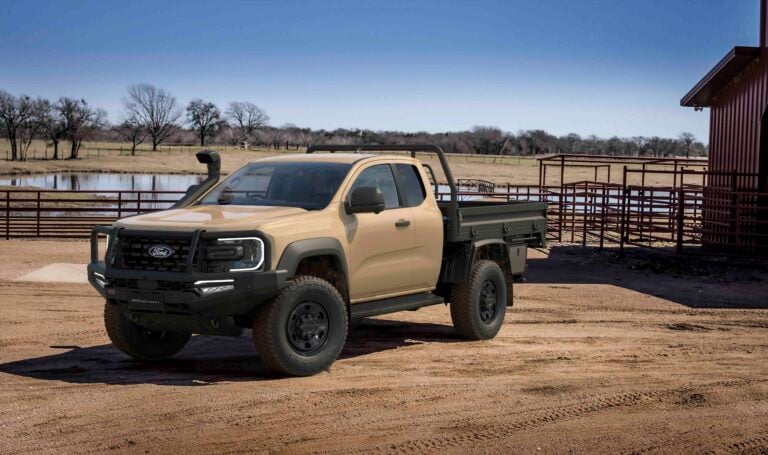 News
NewsFord announces huge range of factory-backed accessories for Ranger Super Duty
Ford has revealed a massive range of factory-backed accessories for the Ranger Super Duty
-
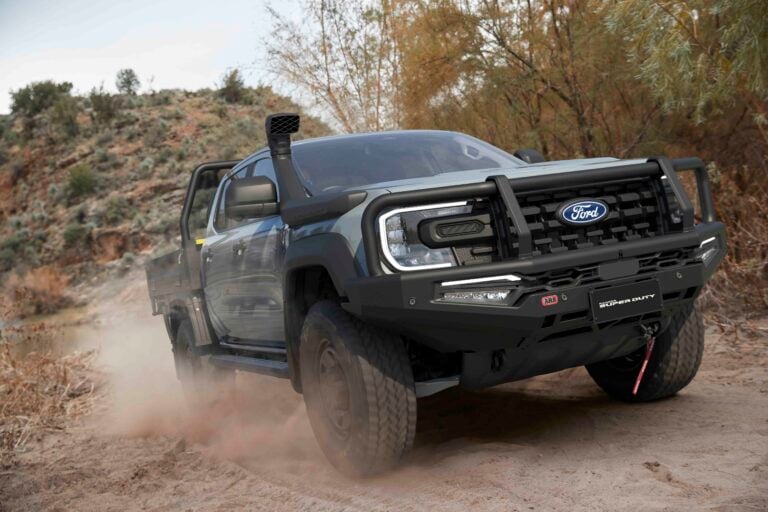 News
News2026 Ford Ranger Super Duty: Full specs revealed
Ford has officially released the full specs for its upcoming 2026 Ranger Super Duty, set to launch in Australia early next year


